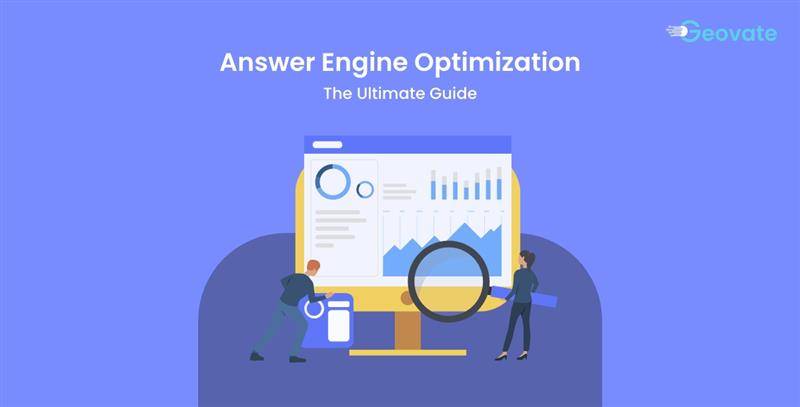Answer Engine Optimization (AEO) in 2025: The Ultimate Guide
Fri,22 Aug 2025 17:12:00- Font Size
- Share Content

Search is evolving. Users are no longer confined to typing queries into a search bar and browsing through pages of blue links. Instead, millions are now turning to AI-driven platforms—from ChatGPT and Microsoft Copilot to Perplexity AI and Gemini—for direct answers.
This major shift in behavior has given rise to a new discipline: Answer Engine Optimization (AEO). Much like SEO helped businesses rank on Google, AEO is about earning visibility in AI-powered conversational answers.
For brands that want to thrive in this new environment, embracing answer engine optimization services is quickly becoming just as important as traditional SEO.
What Is Answer Engine Optimization?
Answer Engine Optimization (AEO) is the practice of structuring and distributing content so that AI-powered answer engines select and cite it when generating responses to user prompts.
Unlike traditional search optimization, which focuses on ranking in search engine result pages (SERPs), AEO ensures your brand, content, or expertise is surfaced in direct, conversational answers.
These “answer engines” include:
- ChatGPT (OpenAI)
- Microsoft Copilot
- Perplexity AI
- Google Gemini
- Anthropic Claude
- Meta AI
Each of these tools is designed to synthesize information quickly, often without requiring users to click through to external websites. That makes answer engine optimization services both a challenge and an opportunity: you must optimize to be the source of truth these platforms pull from.
Why Answer Engine Optimization Matters in 2025
- Search Behavior Is Changing
A growing share of users prefer instant, conversational answers instead of scrolling through websites. Research suggests that by 2026, a quarter of organic search traffic will shift to AI-driven assistants and chatbots.
1. First-Mover Advantage
Businesses that adopt AEO services early will stand out. Just as early adopters of SEO dominated search results, those who build authority with AI engines now will reap long-term visibility benefits.
2. Quality Leads Over Traffic Volume
While raw website traffic may decline as users get answers directly from AI, the referrals that do come through are often more qualified, engaged, and conversion-ready.
3. Future-Proofing Digital Strategy
Answer engine optimization doesn’t replace SEO—it complements it. By optimizing for both search engines and AI engines, brands prepare for a more distributed and AI-integrated digital landscape.
Answer Engine Optimization Services vs. Traditional SEO
Feature SEO AEO
Target Platforms Google, Bing, Yahoo, etc. ChatGPT, Copilot, Gemini, Perplexity, Claude, Meta AI
User Intent Keywords: “best restaurants in Paris” Prompts: “Where should I eat in Paris?”
Metrics Rankings, impressions, backlinks AI citations, mentions, referral traffic
Content Format Blog posts, landing pages, metadata Structured FAQs, authoritative answers, schema-rich content
Goal Visibility in SERPs Inclusion in AI-generated answers
Common Challenges of AEO Services
While the potential of AEO is huge, it comes with unique hurdles:
1. Difficult to Measure Success
SEO tools like Google Search Console or Ahrefs make it easy to track rankings. AEO, however, lacks mainstream free tools. Specialized answer engine optimization services and platforms like OmniSEO™ offer AI citation tracking, but adoption is still limited.
2. Platform Variability
Each answer engine works differently. What helps content appear in Perplexity may not translate the same way in Copilot. Strategies must be flexible and multi-platform.
3. Internal Buy-In
Since AEO services are still new, many organizations hesitate to invest resources. Educating stakeholders about its long-term importance is crucial.
How Answer Engines Gather Information: The Role of AEO Services
To understand answer engine optimization, you need to know how answer engines generate responses:
1. Training on Large Datasets
AI models are trained on massive text datasets, which include publicly available web content.
2. Retrieval-Augmented Generation (RAG)
Some engines (like Perplexity or Bing Copilot) supplement model knowledge with real-time web retrieval. They pull information from crawled sources, then generate an answer.
3. Citations and Mentions
Engines may cite sources directly (as Perplexity often does) or synthesize multiple sources without attribution (like ChatGPT).
This means content must be highly structured, authoritative, and consistent across the web to increase the likelihood of being referenced.
Step-by-Step Strategy for Effective Answer Engine Optimization
1. Set Clear Goals
Start small. Instead of aiming for hundreds of mentions, set a target like 1–2 AI citations per quarter. Over time, scale up based on results.
2. Conduct an AEO Audit
- Review your existing content library.
- Identify gaps where conversational queries aren’t addressed.
- Benchmark competitors: Are they being cited by AI platforms?
3. Optimize On-Site Content
- Structure with clarity: Use H2/H3 headings, bullet points, and FAQs.
- Add schema markup: Article, FAQ, and How-To schema can help.
- Focus on concise answers: Engines favor direct, well-formatted explanations.
4. Expand Off-Site Visibility
- Earn backlinks: High-authority citations boost trust.
- Leverage directories and listings: Local SEO feeds into AEO.
- Promote data-driven assets: Whitepapers, tools, or studies are more likely to be cited.
5. Create Conversational Content
Think beyond keywords. Optimize for prompts, such as:
- “What is the best way to…”
- “How does [topic] work?”
- “What are the top tools for [industry]?”
The more your content mirrors natural conversation, the better it aligns with AI queries.
6. Track and Refine
- Perform manual searches across answer engines for priority queries.
- Log mentions, citations, and referral traffic.
- Use paid AEO services where possible to gain deeper insights.
The Future of Answer Engine Optimization Services
1. Better Analytics – Expect more platforms to release tools that help track AI-driven traffic and mentions.
2. Integration with SEO – AEO will increasingly be seen as part of a holistic search strategy, not a separate discipline.
3. Rise of Specialized Content – Brands will create AI-ready knowledge hubs designed specifically for answer engine consumption.
4. Greater Personalization – As AI engines learn from user context, answer engine optimization services will need to adapt for highly personalized answers.
Final Thoughts: Why AEO Services Are the Future of Search
Answer engine optimization is not a passing trend—it’s the next frontier of search visibility. As AI platforms continue to dominate the way people gather information, businesses that embrace AEO services today will stay ahead tomorrow.
By structuring content for clarity, ensuring authority, and tracking AI citations, you can position your brand as a trusted source in the AI-driven search era.
The future of search isn’t about being “ranked.” It’s about being referenced. And answer engine optimization services are the strategy that gets you there.
Frequently Asked Questions
Q1. What is Answer Engine Optimization (AEO)?
A. Answer Engine Optimization (AEO) is the process of optimizing content so that AI-powered platforms like ChatGPT, Copilot, and Perplexity select and cite it when generating answers for user queries.
Q2. How is AEO different from SEO?
A. SEO focuses on ranking in search engine results pages (SERPs), while AEO focuses on being included in direct, conversational answers generated by AI engines. Both share principles like content quality and authority, but AEO emphasizes structured, concise, and conversational content.
Q3. Why is AEO important for businesses in 2025?
A. With more users relying on AI assistants for quick answers, businesses that adapt to AEO gain visibility in AI-generated results. This helps future-proof digital strategies, capture highly qualified leads, and stay ahead of competitors.
Q4. How do you optimize for AI platforms like ChatGPT and Copilot?
A. You can optimize for AI answer engines by:
- Structuring content with clear headings and FAQs
- Using schema markup (FAQ, How-To, Article)
- Building authoritative backlinks
- Publishing concise, direct answers that align with conversational queries
